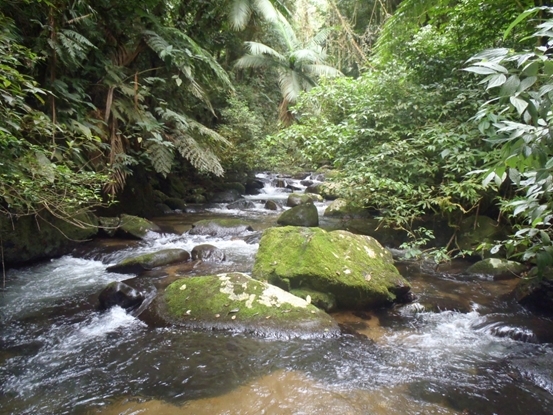


Researchers who studied riverine insect communities in the Atlantic Rainforest and Finland’s boreal forests discovered that random events are more frequent in Brazil (stream in Atlantic Rainforest; photo: Tadeu Siqueira/UNESP)
Published on 03/15/2021
By José Tadeu Arantes | Agência FAPESP – Aquatic insect communities are much smaller in Brazil’s tropical forests than in Finland’s boreal forests, so their response to environmental change has a far larger random component in Brazil than in Finland. In the Atlantic Rainforest, biodiversity may change as the environment changes, but not in the expected manner.
The discovery was made by researchers working on the project “Scaling biodiversity in tropical and boreal streams: implications for diversity mapping and environmental assessment (ScaleBio)”, for which the principal investigator in Brazil was Tadeu Siqueira, a professor at São Paulo State University (UNESP) in Rio Claro. The project was supported by FAPESP under the auspices of a cooperation agreement with the Academy of Finland (AKA). The findings are published in Ecology, a journal of the Ecological Society of America (ESA).
“The study showed that there’s a community size gradient and that this may have to do with climate,” Siqueira said. “On average, the number of insects in communities in Brazil is only a fifth of the number in communities in Finland, and because of their smaller size, they’re much more subject to random demographic events. As a result, they vary less predictably.”
Some variations in nature are deterministic. Species distribution and abundance correlate closely with environmental conditions, for example. Others appear to happen stochastically (randomly). Community assembly can therefore evolve in many different ways. This phenomenon of random change is known as “ecological drift”.
The term is appropriate because the phenomenon is comparable to a boat that is adrift. The boat’s engine corresponds to the deterministic component. If the engine dies, the boat drifts in unpredictable directions.
“In the case of ecological drift, the outcome of the changes that occur in a community is unpredictable. When the number of individuals on the site is small, there’s an increased probability that ecological drift will play a more important role,” Siqueira said.
“Think of a stream with rapids, inhabited by only five insect species. There are two or three individuals of each species in the community. The probability that these individuals will die before they can reproduce so that the respective species will become locally extinct, is much higher than in a large community. This may have nothing to do with the temperature of the water in the stream, the amount of food, or any other environmental factor. Individuals just happen to die before they can reproduce. There are very few of them, and the species disappears.”
In a large community with many individuals, the probability that they will all die before they can reproduce is very low. “It’s highly likely that some will survive and reproduce,” Siqueira said. “if the site is suitable for the species, its relationship with the environment will match the theoretical predictions. If there is significant ecological drift, that relationship is disrupted.”
This explains why the state of São Paulo has river basins where land use – pasture, eucalyptus stands, sugarcane plantations etc. – has heavily affected the environment but biodiversity has not responded as expected to the transformation of the landscape. There are situations in which no relationship at all appears to exist. In fact, there may be a relationship, but changes do not match the predictions of deterministic models because of the strong influence of random events.
“We designed this joint project with colleagues in Finland in order to try to understand this unexpected behavior,” Siqueira said. “We used the same method, the same kind of equipment to collect the insects, the same procedure to identify the specimens collected – all materials and methods were identical.”
The fact that insect communities are far smaller in Brazil than in Finland is counterintuitive, but Siqueira has several theories and intends to test them in future research. One is that because conditions in Brazil are favorable all year long, species reproduce frequently and tend to have shorter life cycles, with many generations per year. In Finland, on the contrary, there is only one very short window of opportunity each year for insects to become adults, mate, and lay eggs. The rest of the time individuals just feed and slowly grow.
“It could be that a single collection in Finland captures all the individuals produced that year, whereas in the Atlantic Rainforest it gleans only the most recent individuals, those that haven’t died or migrated to other niches,” he ventured.
“There’s a species of insect in Brazil, a chironomid, that goes from egg to egg in seven days. In Finland, there are species that take two years to complete a life cycle. But that’s a subject for future research. This latest study of ours showed very clearly that community size varies greatly. It’s possible to find communities with a dozen or two dozen individuals belonging to different species on some Brazilian streams. Some are more populous, with as many as 300 individuals. In Finland, the streams with the smallest number of individuals are more populous than that.”
Siqueira concluded with a prediction. “Climate change, dwindling native cover, pollution etc. tend to lead to smaller ecosystems and communities. This will make ecosystem behavior even less predictable and ecosystem management even more challenging,” he said.
The article “Community size can affect the signals of ecological drift and niche selection on biodiversity” can be retrieved from: esajournals.onlinelibrary.wiley.com/doi/abs/10.1002/ecy.3014.
Source: https://agencia.fapesp.br/35067